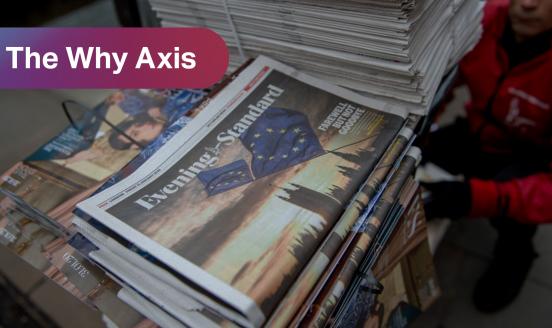2016: The end
What’s at stake: 2016 is coming to an end. It will be remembered as an annus mirabilis and horribilis, at the same time. 2016 brought us some previous
First, a due tribute to 2016. Tony Barber argues that we can summarise this year in one single word. The word in question is “Bundespräsidentenstichwahlwiederholungsverschiebung”, which roughly translates as “postponement of the repeat of the run-off election for federal president”, in references to the postponed re-run of the second round of this year’s Austrian presidential election. It has 51 characters, it takes 4 seconds to say (probably more, if your mother tongue is not German) and accurately depicts the confusion that dominated 2016.
FiveThirtyEight has collected the best and the worst data stories of 2016. Many prizes were assigned to both categories, so we’ll just report a few of the winners. The “Prize For Statistical Fortitude” went to the Los Angeles Times Poll, which during this year’s presidential campaign was the only major national poll that consistently showed Donald Trump leading in the popular vote. The honors for “Best Use Of Data To Speak Truth To Power” goes to Marc Edwards for his work on the water crisis in Flint, Michigan. Turning to the less prestigious category, the “Boldest Sacking Of Experienced Humans In Favor Of Untested Algorithm“ went somewhat unsurprisingly to Facebook, while Donald Trump won the “ ‘Are We Still Doing This?’-Award For Willful Misinterpretation of Government Statistics”.
Turning to 2017, what do people expect? Some interesting data come from the WIN/Gallup International Association’s End of Year survey. This is a global study that collects the public’s view on the challenges that the world faces today, run every year since 1977. The good news is that 68% of the world said that they feel happy about their lives, an increase from 66% last year and 42% of the world is optimistic about the economic outlook for 2017.
However, if we look at the results for the EU, things are less rosy. In the EU, 42% of respondents are pessimists with regards to the economic prospects of their country. No European country - except Estonia - features in the top-10 of more optimist countries, which happens to be mostly emerging markets. But EU and especially Euro area countries feature prominently in the global top-10 of more pessimist countries. Italy is the world’s most pessimist country as far as the Hope Index is concerned, followed by Greece (3rd place), Bulgaria (7th), Belgium (8th) and Austria (9th). As far as the economic situation is concerned, the top 10 is made almost entirely of EU countries: Greece again is the world’s third most pessimist country, followed by Italy (6th), Belgium (7th), Austria (8th), the UK (9th) and France (10th).
Martin Wolf argues that indeed more perils lie in wait for the eurozone, as divergence in the performance of members of the single currency is a real challenge and so long as the eurozone fails to deliver widely shared prosperity, it will be vulnerable to political and economic shocks. Moreover, the year will be constellated by important political event (see Open Europe here, for a 2017 political calendar).
At the global level, Jeffrey Frenkel lists five key factors for 2017. First, the continued uncertainty over what US policies will come out of the new Trump Administration, followed by the strong dollar and widening US trade deficits. Difficulties in some Emerging Market countries, especially those dependent on commodity exports and/or with debts denominated in dollars will also be important as it will be China being forced to choose between halting the depreciation of the RMB versus further internationalization of the currency. The possible end of a 70-year period of US-led global progress toward a liberal international order is obviously a key concern. Adam Slater of Oxford Economics has also compiled a list of the 10 themes to look out for in 2017, which you can find over at Business Insider.
For the US, Bill McBride at Calculated Risk also offers ten economic questions for the US economy in 2016. Tim Duy at Economist’s Watch wonders whether the Fed in 2017 will experience a repeat of 2016. In the most recent Summary of Economic Projections, Fed officials penciled in three 25bp rate hikes for 2017. This however is neither a promise nor a forecast, and the reality could be very different (we all remember how “four” became “one” in 2016). Yet, it is hard to see the the case for a Fed pause in 2017. J. Bradford DeLong argues that in 2017 we will officially enter the “Age of Incompetence”. Trump will begin his presidency with an approval rating below 50%. This is an unprecedented signal that the government of the world’s oldest democracy is, in fact, not democratic. Also unprecedented is the fact that few members of the president-elect’s party, and none of the Democratic opposition, consider him to be fit for duty.
Lastly, The Economist’s Buttonwood rather than looking at what to expect, looks at where surprises could come from. The first surprise may be that Trump’s fiscal policies will be less effective than expected. The the second surprise may be that government bonds do not do that badly. The third potential surprise would be the avoidance of EU disintegration, if Marine Le Pen is defeated in France and Angela Merkel is re-elected in Germany. Another potential surprise in 2017 could come from a big market disruption, like an inexplicable (if temporary) crash in a vulnerable market, such as high-yielding corporate bonds. The final surprise may be served up by that most enigmatic of metals—gold, whose price is unpredictable at a time of political risk.



